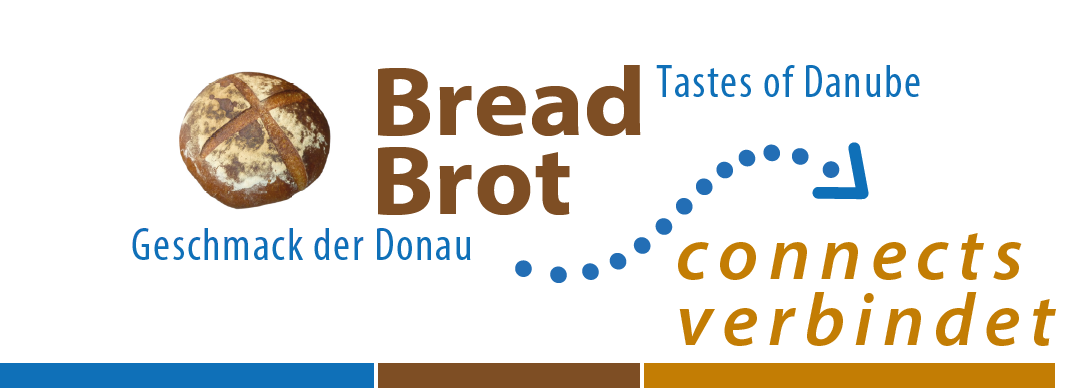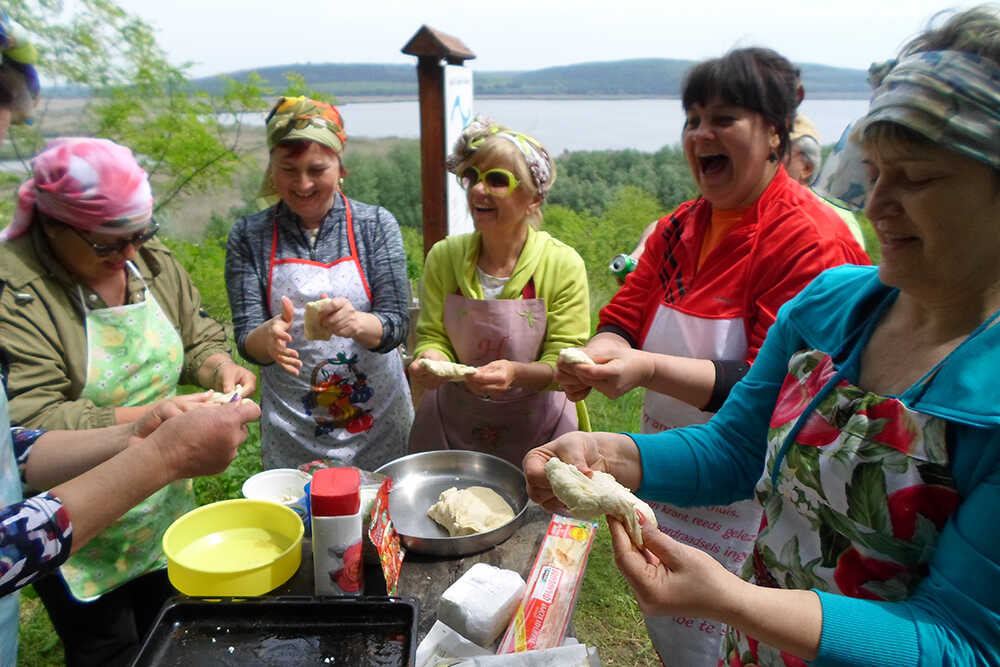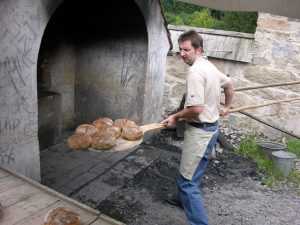The qualification training “Bread as a social event” was held in Sofia from 8th to 11th October 2017 conducted by Zdrava Vodenicharova and Sandra Topalska from the Bread house Network.
Slovenian Third Age University had two representatives at this qualification training who are used to work in small scale educational projects mostly in the area of raising awareness about the value of architecture and urbanism. The two participants arch. Meta Kutin and Alenka Zupan, a U3A student agreed to use and eventually modify the method build by . Bulgarian anthropologist and combine it with the andragogical expertise of Slovenian U3A to set up three workshops for the excluded vulnerable groups followed by a one day theoretical reflection and training of potential qualification training leaders.
UNDERSTANDING THE RATIONALE OF THE TRAINING RELATED TO BREAD
In the Danube region, bread is not just staple food, not just a product, it is much more (web site of the project), Moreover, bread
- is a reflection of social relations,
- contributes to building economic, social and symbolic values.
- bread participates in the construction of collective memory.
- bread expresses communal identity. At community meals and gatherings bread has been meant to contribute to
- the building of ’ fellowship, solidarity and brotherhood ”between the members of the gathering,
- a communion that rarely exists in harsh society of separated social groups.
STEP BY STEP DESCRIPTION OF THE APPLIED BULGARIAN METHOD
Having already developed a fair number of new and innovative small-scale projects, drawing on andragogical disciplinary knowledge and experientially acquired knowledge and skills, the two participants described the steps of applied Bulgarian method as follow
- Introduction to the project and its aims
The Bread connects project was presented focusing on its aims connected with fostering communities on all levels including the level of the Danube region and European union.
- Ice breaking activity. Introduction of the participants
Flour was spread on the floor and discussion was entailed with the participants (building community) about flour as a product (bread and its economic as well as nutritional value).
The participants drew pictures in the spread flour explaining to the group the meaning of their picture (fostering individual identity and building bridges to each other, especially when describing events and triggered emotions)
- Discussing baking bread, adding salt and additional ingredients etc.
(experiential learning and interactive activities)
- Preparing dough, discussing
Pair work. Reciprocal, mutual learning and learning by doing. Members of pairs discussed and exchanged their experience. Common working on the same dough together (symbolic value: fellowship, solidarity, brotherhood).
- Individual or pair modelling the dough, baking the bread
- Individual explaining or pair reporting to the group the meaning of the shape of product and its symbolic value (Intercultural learning of participants from different national and ethnic backgrounds). Moreover, it is to be noted that each local group as well have their own culture that is to be exposed in the group)
- Eating bread together (communion)
- A blind girl joined the group offering to the group her specific abilities and sharing with the group its way of perception.
This part of the qualification training was rather “artificial” but it was meant to put the participants in the shoes of their potential participants in the groups to be created upon their return to their own countries and social environment.
THE METHOD WAS MODIFIED/ UPGRADED
to fit both into
Slovenian U3A mission of socially engaged education and arts of older people and intergenerational dialogue fostered through creating innovative community social practices.
Further fostering belonging to the Danube region and European Union.
Parts of the Bulgarian method were preserved others were modified or interpreted in Slovenian Third Age University’s own way.
AIMS OF THE WORKSHOPS/ qualification training
- Transmission of the intangible cultural heritage
- Fostering intergenerational communities within a given urban territory
- Consolidating European identity and awareness
THE MODIFIED METHOD
The project was preceded by purposive collecting stories of local inhabitants focusing on their past way of living, baking bread, consuming it and writing a bilingual brochure to be distributed in public.
The ethnographic descriptive method was applied. A whole study group in the field of architecture, urbanism and anthropology had been involved in this task.
- Introduction of the project and its aims.
This part was basically preserved but the introduction was supplemented by presenting bread from different angles based on theory of bread and its different values as described above.
- Ice breaking activity. Introduction of the participants.
The painting study groups presented their pictures of bread contained in a catalogue prepared for the project the Taste of Danube. The meaning of pictures was discussed. The rest of the method was preserved.
Flour was spread and discussion was entailed with the participants) building community) about flour as a product (bread and its economic as well as nutritional value).
The participants drew pictures in the spread flour explaining to the group the meaning of their picture (fostering individual identity and building bridges to each other, especially when describing events and triggered emotions).
- Discussing baking bread and adding salt and additional ingredients etc.
- Preparing dough, discussing
- Individual or pair modelling the dough.
- Eating bread together (communion). This part was supplemented by listening to a French song on making and selling bread translated into Slovene by courtesy of a French learning study group and by transmitting stories about living in the past, baking and consuming bread I construction of collective memory)
- The two groups involved in the workshops are both considered as groups with special needs according to Slovenian and Bulgarian law. Older people were supposed to share their stories about bread and make the young newcomers to the Old town of Ljubljana profit from them. The young people also talked about their own attitude to bread.
THE METHOD WAS UPGRADED TO FIT BOTH INTO
Slovenian U3A mission of socially engaged education and arts of older people through and intergenerational dialogue fostered through creating innovative community social practices.
Fostering belonging to the Danube region and European Union.
THE QUALIFICATION TRAINING IN SLOVENIA
was meant to further spread the method. During the three workshops were present the observers:
- Dušana Findeisen
- Andrej Gržin, a baker who runs socio-cultural animation projects
- Urška Telban, a mentoress at Slovenian Third Age University from Vrhnika
- Urška Majaron, from Ljubljana’s Third Age University
- Andreja, an architect interested in the method
Their observations were later discussed in a qualification training joined by students of Slovenian Third Age University and supplemented by bread theories originating from scientific and professional articles or their specific studies.
The method was further presented in international meetings (to the group of feminists from Zagreb, to mentors from the network Slovenian U3A, to the 10th ELOA conference in Ljubljana etc.)
Urška Telban decided to insert this method as one of our activities for U3A volunteers working with socially marginalised groups as intangible culture transmitters (mediators in culture)
From the brochure/leaflet on bread
Introduction
Today, there is Bakery 8 in the Old Market in Ljubljana. Old baking techniques are being revived and used in this bakery.
Slovenian Third Age University older students born in the area took part in three workshops together with young generations, new comers to this town area. Both learned how to make bread, talking to each other about the old and new times. Learning by doing helped them to be together, to learn together and to understand better each other.
Read about what was being said while baking bread
It happened seven years after the Second World War and I belong to the generation born after the war. In those times there was enough bread to eat but large self-service stores did not exist yet. So, there were not 77 types of bread waiting for the customers as they do today.
Therefore, we still made the dough at home and had it baked in the bakery nearby. Each time my grandma made a big heavy loaf of bread; she prepared an elongated recipient, put a napkin into it, spread flour over the napkin and laid the bread on it. It reminded me of a woman putting her baby in a cradle. She tore off a bit of newspaper and using an ink pencil, she wrote down our family name then “hurt” the dough with her finger and pasted this ID into the hole she had made. Then she wrapped the dough in the napkin. She put the left corner of the napkin on the top of the dough, then the right one and then it was my turn to take over the task. I had to get the bread to the bakery (M.K)
The baker was standing deep in the hole, so deep that me, a little boy, looking over the edge of the table, could not see him. The baker gave a respectful tap to the dough, then disrespectfully cut into it three times. The dough had to rise once more. “At eleven,” the baker ordered standing in front of the oven and putting the bread into it.(M.K.)
The bread crust looked incredibly inviting. Our post-war born generation, were naughty and lively and just before lunch the whole generation, I guess, felt very hungry. That is why my first demand after I delivered the bread was:“Grandma, please will you cut off a piece of bread for me. Just the crust, and one for my neighbour”. Grandma did it according to my instructions because she knew we were the generation that would have to struggle for “better future”. So, by lunchtime, the loaf was already naked, no crust to be seen. Tired after work our parents came hone and they had to eat it “naked”. Of course, a malicious historian would skip the facts and report how spoiled they were.(M.K.)
Once a week I was sent to Breg No 6 a street over the bridge along the river bank. I carried there a container with dough inside gave it over to the baker, who and in return gave me a small paper with a number and ordered me to wait. The baker pasted the numbered paper on the loaf. A warm, acid smell was coming from the bakery. There was moss on the walls. On our way home, the children sometimes ate the white part of the bread, so that only crust arrived home. (Katarina 64)
Saturday, 2.3.2019
Saturday, 16.3.2019
Saturday, 23.3.2019



